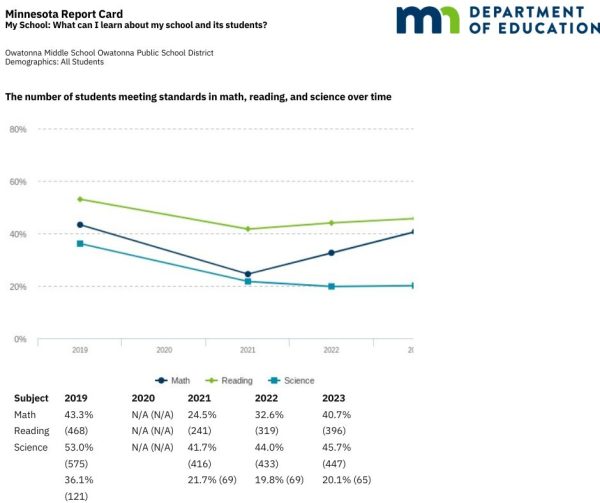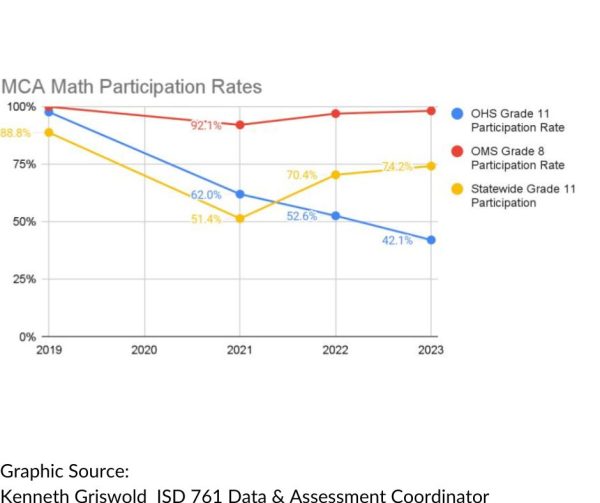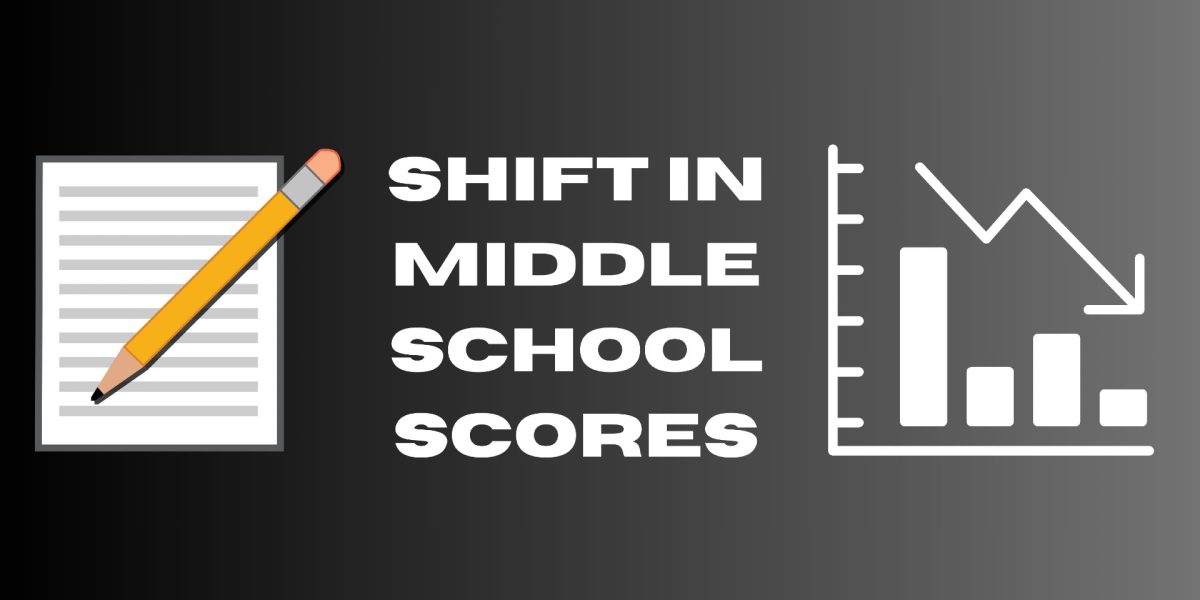During the pandemic, classes were moved online, and later to hybrid. During the hybrid system, students spent just two days a week in the classroom. While hybrid learning benefited some students with the gift of more time, others were deprived of valuable time of being social with friends.
In 2019, the Owatonna Middle School had 53.0 percent proficiency in reading, 43.3 percent proficiency in math and 36.1 percent proficiency in science. In 2023 all of those numbers dropped. The 2023 OMS proficiency rates of reading were 45.7 percent, math was 40.7 percent and science at 20.1 percent. These rates, excluding science, have increased from 2021, but are still behind the 2019 rates. In analyzing this data, the ISD 761 district has goals to improve students’ performance moving forward.

Testing data for proficiency rates at the OMS.
The MCA’s
The MCA’s are the statewide standardized tests that students in third through eleventh grades are strongly urged to take. There are three different categories of the MCA: science, math, and reading. These tests have been a way of assessing students since 1998.
Standardized test scores of students in middle schools around the country have been decreasing in recent years. Students within the Owatonna Middle School had much lower MCA scores during the 2021-2022 school year. There was a steady decline with a small bounce back in 2023 in regards to the overall theme of scores in middle school. The levels of proficiency across all categories of the MCA test are lower than they were in 2019. There are many factors that can contribute to these results, one of which being a change in academic culture due to the pandemic.
Participation of the MCA’s is a factor that must be taken into account. While high school participation rates have been dropping at a very high rate in the past few years, middle school participation continues to remain high. For math, the eight grade participation rate dipped in 2021 down to 92.1 percent then returned to near 100 percent. As for eleventh graders, their math participation went from similar to the OMS in 2019, down to just 41.1 percent in 2023.
Students are given the option to have their parents sign a form and opt out of taking the MCA’s. OHS Principal Kory Kath said, “When a student chooses to opt out, that score is considered to be not meeting, so in other words that counts against us as a school.” This process can create a false sense of need for change, especially within the high school.

This verifies the data that middle school scores have dropped since 2019 as participation has dipped only slightly.
Sophomore Isaac Tolzman plans on participating in the MCA’s this year. Tolzman said, “I just really want to see where I’m at; if I’m doing good or not.” He was not aware of the opting out process, or the consequences of doing as such. While the participation rates may be dropping, many students such as Tolzman still plan on seeing where they are at.
Although the scores have been making a comeback since their low point in 2021, they are still lower than they have been in the past. With all of the resources and technology available to students and teachers, it is important to look into the root of the problem in order to progress forward.
In the middle of change
This has drawn attention for articles and coverage due to the many studies being done on the middle school age group. Across the nation this phenomenon has occurred. In an article by The New York Times it says, “Achievement in math declined across lines of race, class and geography. The last time math performance was this low for 13-year-olds was in 1990.”
Middle school has always been a period in students’ lives where change is at the forefront of their experience. They are changing physically, mentally and emotionally. This causes many students finding difficulty adapting.
Ms. Julie Sullivan is the Director of Teaching and Learning in the Owatonna school district. Her job includes reviewing the required curriculum and utilizing funds from the government in a way that is beneficial for the district’s school system. Whether it be working with the training of some 358 professionals with new developments on reading instruction, or both elementary and secondary evaluating principals. Ms. Sullivan overall plays a vital role in the functioning of the ISD 761 school district.
Additionally, Ms. Sullivan was a middle school principal for seven years. She said, “We didn’t have much for like normal years over there. Because the first year we moved in we were under construction.” After that, the school introduced the A and B day schedule, as well as the variety of elective classes that are still offered today.
Ms. Sullivan said, “My biggest takeaway is that it is an interesting age. I have always said you have kids wearing Winnie the Pooh sweatshirts, and then you have kids that look like they are 20 years old. I also think they were probably the most impacted by the pandemic.”
The cultural effects of the pandemic are still being seen today. Ms. Sullivan brought to light the TikTok challenge that involved stealing and breaking things from the school, e.g. paper towel dispensers. While it may be easy to write off as just a dumb challenge that came and went, it is important to recognize the scale of the issue. The age of social media has changed the fundamentals of society, particularly at the middle school level. In an article published by Education Week it says, “Seventy percent of educators say students are misbehaving more now than compared to fall of 2019.”
Students’ scores and attitudes are in need of attention. According to an article by Edutopia, “A real recovery will require not just intensive academic interventions, but also intentional efforts to rebuild students’ social skills.” The effects of the pandemic are evident, with the lack of structure and face-to-face interaction leading to unfiltered real-life interactions.
In the middle of the classroom
Educators deal with a large number of students on a daily basis. It is their responsibility to both teach students what they need to know, but also keep the classroom under control. According to the OMS daily schedule, in an average week a teacher might spend 166-249 minutes with a class. Ms.Angie Iserman is a seventh-grade English teacher at the Owatonna Middle School. She has been teaching in her position since 2014. Ms. Iserman said, “I really like the enthusiasm they still bring into the classroom. When you get into those older grades, you start looking toward the future and it gets a little harder to get you engaged. Seventh graders for example, they’re not thinking that far ahead, so they still come in with a lot of excitement.”
However, every age group comes with their set of challenges. Ms. Iserman said, “The most challenging part is that they don’t always understand why things are important. Developmentally, sometimes they still don’t have the brain capacity to see the big picture.”
Adjusting to the realities of post-pandemic society, the workload on teachers has been a topic for discussion; Ms. Sullivan gave her opinion on the topic. She said, “It’s a discussion we have quite a bit, their job is to educate, but it’s not as easy to just teach you this or that because there’s so many other factors. Today’s teachers are absolutely amazing, but it is hard.”
Ms. Sullivan said, “Parents are working. I think more people are looking to schools for social, emotional, learning and mental health support. Schools can’t solve all of that.”
Teachers continue to front the changes in needs among students. Ms. Iserman said, “The workload has definitely changed. I wouldn’t say it’s more or less, I would definitely say it’s different, though. There’s a lot more use of technology.”
Ms. Iserman said, “I also think that students suffered from their parents being under stress. There are some long term effects that we’re seeing in terms of how it’s affecting kids mentally, with the stress their families were under.” There are many areas that are open for improvement. The school district is searching for ways to adjust moving forward.
Solutions in policy
One major step that has already been taken was the phone policy at the middle school. Students are to have their phone be in their locker for the entire school day, with zero access throughout the day. Ms. Sullivan cited Away For The Day as inspiration for the decision, which has yielded steps in the right direction.
Ms. Iserman said, “I think technology in particular presents some challenges. You can do things with technology and feel like you’re anonymous. Two years ago the middle school went to a no cell phone during the day policy. I think the changes we’ve seen support that idea. There has been less drama in the building when students didn’t have access to their phones during passing time or lunch.”
The implementation of this policy is directly targeting the lack of socialization, as well as the trend of that anonymous feeling one may get when using social media. The filterless culture that stemmed from the explosion of social media is being combated by the tools that are used to facilitate such culture.
Other solutions are curriculum changes and individualized support. An example would be the implementation of functional phonics. While this may be going on at the elementary level, it reflects the willing-to-adapt attitude that the ISD 761 school district possesses.
Ms. Sullivan said, “I went over to Washington Elementary and I was watching these data meetings. If only other people could see how invested they are in individual kids, they had names on the board, saying ‘What’s not working? Okay, maybe we need to try this intervention.’ And that’s happening all over the place. I do think people are working really, really hard. So we just have to make sure that the hard work is the right work.”
The ISD 761 School District is working to find newer and better ways to adapt to the circumstances and to better fit the student body’s needs. Whether it be teachers out in classrooms, coordinators behind the scenes, or lawmakers in our government, changes are being made frequently in order to find what clicks. With the undeniable change that came within our community, comes an undeniable response to get students to a place where they can excel.
MCA testing will occur on March 2, May 1 and May 8, 2024. When the results are published, the results of the district’s efforts will be shown, and direction for the future can be decided.


